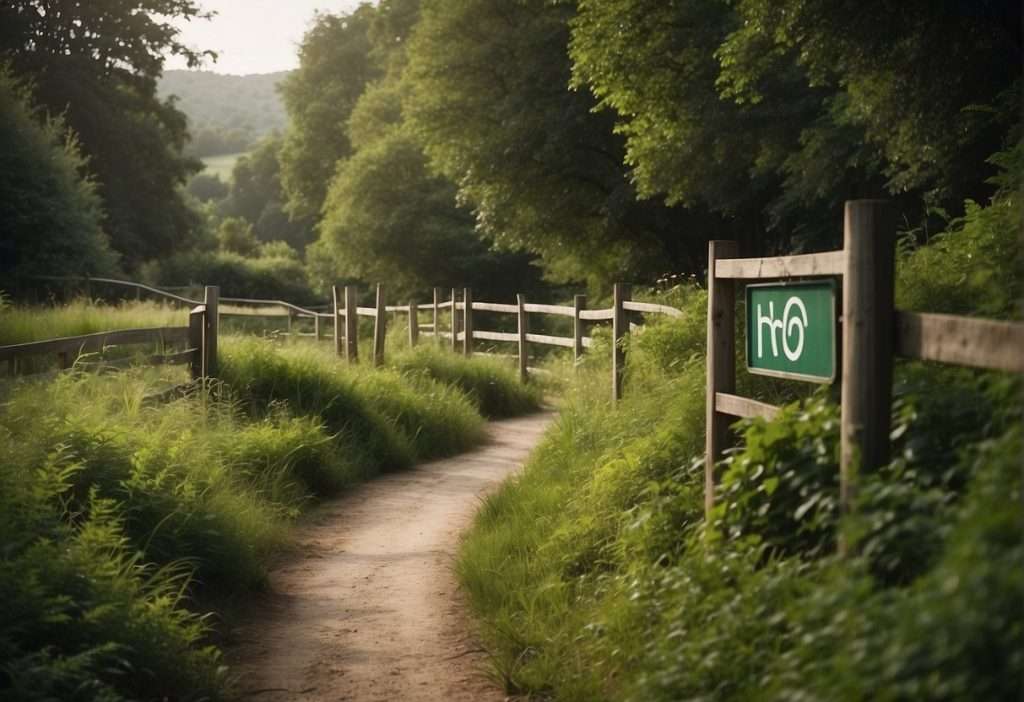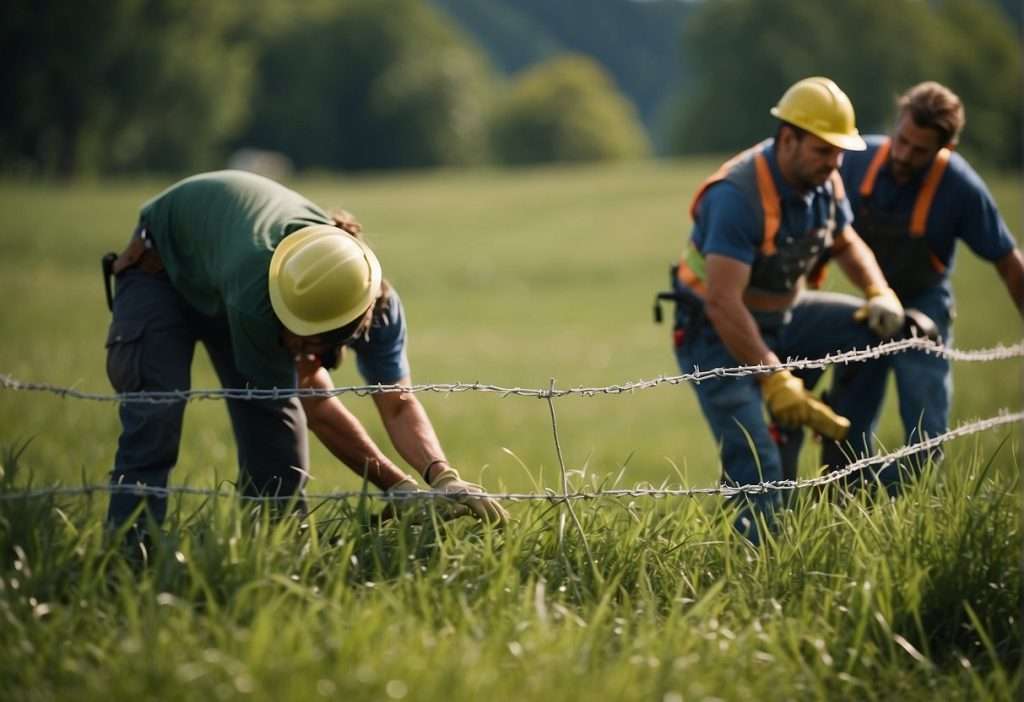Landscaping on an easement can be a complex issue because easements are legal agreements granting specific rights over a property to a person or entity that is not the owner. If you own property where an easement is present, you should be aware that your right to alter or landscape this portion of your property may be limited. Easements are often in place for reasons like utility line placement, access routes, or drainage, and these uses can restrict the types of modifications you can make.

Before making any changes to the land under an easement, it’s essential to understand the type of easement involved and any conditions or restrictions that apply. For example, utility companies typically have guidelines on what can be planted or built on their easements to ensure access for maintenance and operation. The responsibility to maintain the easement area can also vary, often depending on local laws and the specific terms of the easement agreement.
When considering landscaping on an easement, it is prudent to check with the easement holder and local regulatory bodies first. In some cases, a written request for your intended modifications may be required, and obtaining approval is crucial to avoid legal disputes or the need to remove unauthorized landscaping later. It’s important to respect the easement terms, as they serve purposes that might be crucial to infrastructure or neighboring properties.
Understanding Easements
An easement is a crucial part of property law that affects your rights to use a piece of land. Knowing the types, components, and definitions can guide your landscaping decisions.
Definition of Easement
An easement is a legal provision that grants someone the right to use a portion of your property for a specific purpose, even though they don’t own it. This can include, for instance, the right to cross or use the land for utilities, without impeding your overall ownership.
Types of Easements
There are various types of easements, each with its unique characteristics and legal implications:
- Easements Appurtenant: This type of easement involves two separate properties, where the dominant estate benefits from the easement, and the servient estate is encumbered by it.
- Easements In Gross: These grant a right to use the land to an individual or entity, such as a utility company, and do not benefit a particular piece of land.
- Conservation Easements: Designed to protect natural resources, these restrict land use to preserve environmental value.
- Prescriptive Easements: Acquired through continuous use over time without the owner’s permission, operating much like adverse possession.
- Negative Easements: These prohibit specific activities on the servient estate, preserving a particular aspect of the dominant estate, such as a view or sunlight.
Easement Components
To fully grasp easements, you should understand their components:
- Dominant Estate: The property that benefits from the easement.
- Servient Estate: The property that is subject to the rights of the easement holder.
- Right of Use: The specific rights granted by the easement, which may include right-of-way or utility installation.
- Terms of Agreement: Easements are bound by terms that dictate their use and maintenance responsibilities.
By understanding these aspects of easements, you can make informed decisions about the use and development of your property.
Landscaping on Easements
When you own property with an easement, your landscaping options may be limited. It’s crucial to understand what is permissible and what could violate the terms of the easement.
Permissible Landscaping Activities
Light Gardening: You can generally plant flowers, grass, and small shrubs that don’t interfere with the easement’s purpose.
- Plant height: Keep plants short to avoid interference.
Decorative Features:
- Placement: Ensure they are easily removable if access is needed.
Mulching and Ground Cover:
- Materials: Use materials that don’t impede access.
Prohibited Landscaping Activities
Structural Installations: Building permanent structures like sheds is typically not allowed on an easement.
- Example: Gazebos, decks, or pools.
Large Plantings: Trees and large shrubs can damage underground utilities and are usually not permitted.
- Risk: Root growth can interfere with cables, pipes, or lines.
Altering Terrain: Significant changes to the landscape that affect drainage or access are forbidden.
- E.g., Installing raised beds or berms.
Legal Rights and Restrictions

When you are landscaping on an easement, it is important to understand that while you own the property, the easement grants certain rights to others. This affects what you can and cannot do in that specific area.
Understanding Your Rights
Your Rights as a Property Owner:
- You retain ownership of the land.
- You can use the eased area, provided you do not interfere with the rights of those granted the easement.
Neighbor’s Rights
Neighbor’s Rights on the Easement:
- Neighbors may have a right-of-way easement, allowing them passage through your property.
- They cannot obstruct your use of the property outside of their easement rights.
Utility Company’s Rights
Utility Company’s Rights:
- Utility companies usually have the legal right to access the easement for maintenance and emergency purposes.
- They may restrict certain types of plantings or constructions that could interfere with their access or utility infrastructures.
Real Estate Considerations
When it comes to landscaping on an easement, understanding the real estate implications is crucial for maintaining property value and preempting legal disputes.
Impact on Property Value
Landscaping on a property easement can have a significant effect on your property value. When done properly, it can enhance the overall aesthetic appeal and contribute positively to the value. However, any changes that violate easement terms may lead to costly remediation and potentially harm the property’s marketability.
- Enlist a Real Estate Agent: A knowledgeable real estate agent can provide insights on how landscaping within an easement may affect resale values in your area.
- Consult with a Title Company: They can clarify the details of the easement recorded on your deed, ensuring that your landscaping plans don’t encroach on the easement rights, preserving the value of your property.
Dealing with Disputes
Disputes over easement rights and landscaping can escalate into lawsuits, which are both time-consuming and expensive. To safeguard your property rights and avoid legal confrontations:
- Seek Legal Counsel:
- Contact a real estate attorney to understand your legal standing.
- Understand the specific stipulations of your property easement and abide by them to prevent disputes.
- Proactive Measures:
- Maintain open communication with the easement holder to ensure mutual understanding of landscaping boundaries.
- If disagreements arise, consider mediation before resorting to a lawsuit.
Working with Entities

When landscaping on an easement, it’s crucial to engage with various entities to ensure your plans are compliant and respectful of shared interests. Addressing legalities and maintaining open communication channels will facilitate a smoother project execution.
Communication with Neighbors
To maintain good relations and avoid potential disputes, it’s important to discuss your landscaping plans with adjacent property owners. Neighbors may have rights or interest in the easement area.
- Discuss your landscape design and how it may impact the shared easement.
- Seek verbal or written consent when appropriate.
Negotiations with Utility Companies
Utility companies often have legal rights to the easement, and they require access for maintenance or emergency services. Your discussions with them should focus on alignment with their guidelines.
- Confirm with Utility Companies the type of landscaping allowed near their lines or equipment.
- Understand the company’s access needs to avoid future complications.
Consulting a Real Estate Attorney
Legal guidance is advisable to navigate the complexities surrounding easements.
- A Real Estate Attorney can clarify your rights and advise on any agreements you might need with other parties.
- They are essential in interpreting any Homeowners’ Association (HOA) rules that may affect landscaping plans.
Easement Maintenance and Repairs

Understanding your responsibilities for easement maintenance and repairs helps ensure proper care and avoid conflicts. This section clarifies the roles you and utility companies play in the upkeep of easements.
Landowner’s Responsibilities
Maintenance:
- Your role: As a landowner, you’re required to maintain the easement in a manner that doesn’t interfere with its use. For example, mowing grass or removing debris is your responsibility.
- Limitations: You should avoid planting trees or building structures that could impede access in a utility easement.
Repairs:
- Initiating repairs: If an issue within the easement is due to your action or neglect, you may need to make repairs.
- Communicating with utilities: For matters involving the utility infrastructure, reach out to the utility company to address the issue.
Utility Company’s Responsibilities
Maintenance:
- Routine inspection and care: Utility companies are responsible for regular inspections and maintenance within the right-of-way to ensure their services run uninterrupted.
- Infrastructure upkeep: Companies are responsible for keeping poles, lines, and pipes in good working condition, which can include pruning trees or managing vegetation.
Repairs:
- Addressing damages: When infrastructure damage occurs, it’s typically the utility company’s task to execute repairs promptly.
- Emergency responses: In emergencies, companies must act quickly to restore services and ensure public safety within the easement area.
Modifying or Terminating an Easement
Your rights to modify or terminate an easement are generally contingent on legal procedures or the circumstances around abandonment or misuse. Understanding the specific legal framework and requirements can protect your interests when dealing with an easement on your property.
Legal Procedures for Change
To legally modify or terminate an easement, you typically need to follow a formal process. This process may involve:
- Court Order: A judge can terminate an easement if it is no longer necessary or if it was made under conditions that no longer apply. For instance, an easement that was granted for a particular purpose may be terminated if that purpose can no longer be fulfilled.
- Release: If both parties agree, a written release of the easement can be signed. This release must be filed with local land records to be effective.
- Legal Considerations: Specific legal grounds, such as the merger of the dominant and servient estates, can result in the termination of an easement. In such a case, if you become the owner of both properties involved, the easement may cease to exist.
It’s crucial to seek legal advice before attempting to modify or terminate an easement to ensure compliance with relevant laws and regulations.
Abandonment and Misuse
Abandonment and misuse are two instances that can lead to the extinguishment of an easement. Here’s how these circumstances work:
- Abandonment: You must demonstrate that the easement holder intentionally and voluntarily relinquished the easement without the intent to return to use it. Evidence of non-use by itself is not sufficient for abandonment; there must be a clear intent to abandon.
- Misuse: If the easement holder significantly changes the use or overburdens the easement, you may have grounds to request its termination. For example, if an easement for residential access is used for commercial traffic, this may be regarded as misuse.
Both abandonment and misuse often require involvement from the courts to officially terminate or modify the easement based on such grounds.
Proactive Measures

When landscaping on an easement, you must understand the intricacies involved in preventing legal conflicts and forging clear agreements. This understanding ensures that you comply with existing easement terms and uphold your legal obligations.
Preventing Conflicts
To prevent conflicts when landscaping on an easement, you should:
- Conduct a Title Search: A comprehensive title search is your first line of defense. It reveals any existing easements on your property.
- Understand Easement Terms: Review the specific terms of the easement detailed in your warranty deed to know what is permissible.
- Rules and Restrictions: Easements often come with rules and restrictions regarding the type of work you can do. Take time to familiarize yourself with these details.
Creating Clear Agreements
Forging clear agreements involves:
- Draft Agreements: If alterations are needed, draft a clear agreement with the easement holder that outlines what changes you are proposing.
- Specify landscaping changes, ensuring they comply with existing easement terms and do not impede the easement’s use.
- Obtain written consent to protect yourself from future disputes.
By taking these proactive measures, you not only adhere to your legal obligations, but you also ensure that your landscaping plans are executed smoothly and without infringement on the rights of the easement holder.


